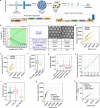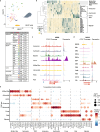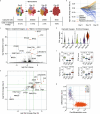Overloading And unpacKing (OAK) - droplet-based combinatorial indexing for ultra-high throughput single-cell multiomic profiling
- PMID: 39443484
- PMCID: PMC11499997
- DOI: 10.1038/s41467-024-53227-z
Overloading And unpacKing (OAK) - droplet-based combinatorial indexing for ultra-high throughput single-cell multiomic profiling
Abstract
Multiomic profiling of single cells by sequencing is a powerful technique for investigating cellular diversity. Existing droplet-based microfluidic methods produce many cell-free droplets, underutilizing bead barcodes and reagents. Combinatorial indexing on microplates is more efficient for barcoding but labor-intensive. Here we present Overloading And unpacKing (OAK), which uses a droplet-based barcoding system for initial compartmentalization followed by a second aliquoting round to achieve combinatorial indexing. We demonstrate OAK's versatility with single-cell RNA sequencing as well as paired single-nucleus RNA sequencing and accessible chromatin profiling. We further showcase OAK's performance on complex samples, including differentiated bronchial epithelial cells and primary retinal tissue. Finally, we examine transcriptomic responses of over 400,000 melanoma cells to a RAF inhibitor, belvarafenib, discovering a rare resistant cell population (0.12%). OAK's ultra-high throughput, broad compatibility, high sensitivity, and simplified procedures make it a powerful tool for large-scale molecular analysis, even for rare cells.
© 2024. The Author(s).
Conflict of interest statement
B.W., H.M.B., X.Y., A.S., C.Eidenschenk, C.Everett, E.V.N., H.C., C.C., J.L., M.S., J.M.L., A.X.M., N.P., Y.L., Z.M. and S.D. are currently employees of Genentech and shareholders of Roche. The remaining authors declare no competing interests.
Figures



References
Publication types
MeSH terms
Associated data
- BioProject/PRJNA1046517
- Actions
- Actions
- Actions
- Actions
- Actions
Grants and funding
LinkOut - more resources
Full Text Sources
Research Materials
Miscellaneous

